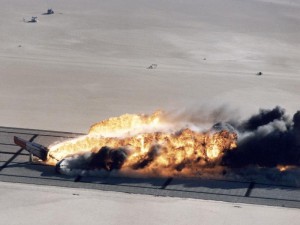Crash Test TV
Destroying a 727 in the name of science…and entertainment
/https://tf-cmsv2-smithsonianmag-media.s3.amazonaws.com/filer/d7/85/d78553e6-5bc3-45cf-a7a4-6d2eeff77532/discovery_curiosity.jpg)
The odds of you being killed in an airplane crash, dear reader, are a million to one. But that didn’t stop the Discovery Channel from loading a 727 with a dazzling array of sensors and crashing it into the Mexican desert, all in the name of science. The results of the experiment will be aired this Sunday, October 7, as the season premiere of “Curiosity.”
Among other things, the filmmakers wanted to determine if there was anything a passenger could do to improve his or her odds of surviving. Where should you sit? Does bracing help, or is that an old wives’ tale? Crash-test dummies (which cost $150,000 each and provide 32 different types of data) were placed throughout the aircraft. Some were set in the brace position, while others were seated upright. “Low-tech dummies” were also used, either buckled into their seats, or seated without restraints.

A masterpiece of understatement: "It was not exactly the impact that was hoped for," reads NASA's caption of its Boeing 720 fireball. Photograph courtesy NASA.
An experiment on this scale, notes the film, has been tried only once before. In 1984, NASA spent millions crashing a Boeing 720 into Rogers Dry Lake in the California desert. But the aircraft lost control on the final approach and burst into flames after crashing—not good for collecting data. (The experiment was part of a joint research project between NASA and the FAA to test the effectiveness of a fire-suppressing fuel additive.)
Watch a clip from the show, below: